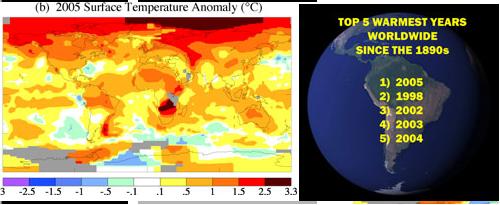Climatologists at NASA's Goddard Institute for Space Research in New York wrote that the highest annual average on the ground was the highest year in over a hundred years, according to initial analyzes of 2005

The year 2005 was probably the hottest year in the last century. This is according to a NASA study that examined heat measurements around the world.
Climatologists at NASA's Goddard Institute for Space Research in New York wrote that the highest annual average on land was the highest year for more than a century, according to initial analyzes of 2005.
Other research groups examining climate change ranked 2005 as the second year at the Wall in a November-to-November comparison. The main differences between the analyses, NASA scientists say, is the inclusion of the Arctic region in NASA's analyses. Although there are very few weather stations in the Arctic region, the available data indicated that 2005 was particularly warm in the Arctic region.
To assess whether the Earth is cooling or warming, the scientists used temperature data from weather stations on the ground, satellite measurements of the sea surface temperature that have been measured continuously since 1982, as well as data from ships for the years before that.
The warmest year so far was 1998 when the El Niño event - a flow of warm water in the eastern Pacific Ocean added to global warming. But what is important, whether the 2005 data show it was the hottest year or the second warmest year, is that global warming returned to the level of 1998 without the help of El Nino.
The results indicate a clear trend of warming. Global warming since the mid-seventies was about 0.6 degrees Celsius. Cumulative warming in the last century has reached 0.8 degrees Celsius. The five warmest years of the last century were recorded during the last eight years, says James Hansen, director of NASA's GISS. These are the years 1998, 2002,2003,2004, 2005, XNUMX and XNUMX.
The current warming is felt almost everywhere at the same time and is greatest in the high latitudes of the Northern Hemisphere. Over the past 50 years, the largest annual and seasonal concentrations have occurred in Alaska, Siberia, and the southern Antarctic Peninsula. Most areas of the oceans have warmed. Since these areas are isolated and far from major cities, it is clear to climatologists that the specialization is not only due to the effect of pollution in urban areas.
